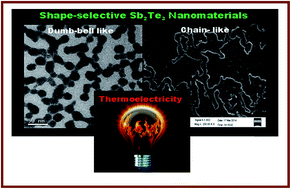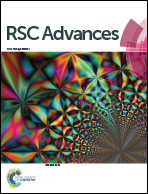Low temperature, shape-selective formation of Sb2Te3 nanomaterials and their thermoelectric applications†
Abstract
Shape-selective Sb2Te3 nanomaterials have been synthesized utilizing a simple wet-chemical route at a low temperature within a short time. Dumb-bell like and chain-like Sb2Te3 nanomaterials are formed by the reaction of Te metal powder with SbCl3 salt in the presence of alkaline 2,7-DHN in CTAB micelle media at 80 °C temperature. The size and shape of the nanomaterials can be easily tuned by changing the molar ratio of the surfactant to metal salts and controlling the other reaction parameters. The middle part of the dumb-bell like shapes is ∼15 ± 1 nm, and the length ∼ 50 ± 7 nm while the diameter of the chains is ∼125 ± 7 nm. The opto-electronic properties, thermal stability and specific growth mechanism for the formation of different shapes are elaborated in detail. Both morphologies have been tested for thermoelectric applications. Among the two different morphologies, the chain-like morphology gives a better thermoelectric figure of merit (ZT) value compared to the dumb-bell like morphology at 300 K. The increase in ZT value of the chain-like morphology is due to reduction of the lattice thermal conductivity via the effective phonon scattering that is present at the interface between boundaries of the nanograins and in the rough surfaces of the nano-chains. The maximum ZT temperature moves significantly to the high temperature zone indicating that the shape-selective Sb2Te3 nanomaterials have potential application in power generation.


 Please wait while we load your content...
Please wait while we load your content...